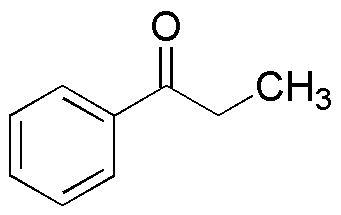1-Phenyl-1-propanone is widely utilized in research focused on:
- Pharmaceutical Development: This compound serves as a key intermediate in the synthesis of various pharmaceuticals, particularly in the production of analgesics and anti-inflammatory drugs, enhancing their efficacy and reducing side effects.
- Flavor and Fragrance Industry: It is used as a flavoring agent and fragrance component, providing a sweet, floral aroma that is desirable in perfumes and food products, making it a popular choice among manufacturers.
- Organic Synthesis: As a versatile building block, it is employed in organic synthesis to create complex molecules, facilitating research in academic and industrial laboratories focused on developing new materials and compounds.
- Polymer Chemistry: This chemical is utilized in the production of polymers, particularly in creating specialty plastics and resins, which are essential in various applications ranging from packaging to automotive parts.
- Analytical Chemistry: It acts as a standard reference material in analytical chemistry, aiding researchers in the calibration of instruments and validation of methods, ensuring accuracy in chemical analysis.
General Information
Properties
Safety and Regulations
Applications
1-Phenyl-1-propanone is widely utilized in research focused on:
- Pharmaceutical Development: This compound serves as a key intermediate in the synthesis of various pharmaceuticals, particularly in the production of analgesics and anti-inflammatory drugs, enhancing their efficacy and reducing side effects.
- Flavor and Fragrance Industry: It is used as a flavoring agent and fragrance component, providing a sweet, floral aroma that is desirable in perfumes and food products, making it a popular choice among manufacturers.
- Organic Synthesis: As a versatile building block, it is employed in organic synthesis to create complex molecules, facilitating research in academic and industrial laboratories focused on developing new materials and compounds.
- Polymer Chemistry: This chemical is utilized in the production of polymers, particularly in creating specialty plastics and resins, which are essential in various applications ranging from packaging to automotive parts.
- Analytical Chemistry: It acts as a standard reference material in analytical chemistry, aiding researchers in the calibration of instruments and validation of methods, ensuring accuracy in chemical analysis.
Documents
Safety Data Sheets (SDS)
The SDS provides comprehensive safety information on handling, storage, and disposal of the product.
Product Specification (PS)
The PS provides a comprehensive breakdown of the product’s properties, including chemical composition, physical state, purity, and storage requirements. It also details acceptable quality ranges and the product's intended applications.
Certificates of Analysis (COA)
Search for Certificates of Analysis (COA) by entering the products Lot Number. Lot and Batch Numbers can be found on a product’s label following the words ‘Lot’ or ‘Batch’.
*Catalog Number
*Lot Number
Certificates Of Origin (COO)
This COO confirms the country where the product was manufactured, and also details the materials and components used in it and whether it is derived from natural, synthetic, or other specific sources. This certificate may be required for customs, trade, and regulatory compliance.
*Catalog Number
*Lot Number
Safety Data Sheets (SDS)
The SDS provides comprehensive safety information on handling, storage, and disposal of the product.
DownloadProduct Specification (PS)
The PS provides a comprehensive breakdown of the product’s properties, including chemical composition, physical state, purity, and storage requirements. It also details acceptable quality ranges and the product's intended applications.
DownloadCertificates of Analysis (COA)
Search for Certificates of Analysis (COA) by entering the products Lot Number. Lot and Batch Numbers can be found on a product’s label following the words ‘Lot’ or ‘Batch’.
*Catalog Number
*Lot Number
Certificates Of Origin (COO)
This COO confirms the country where the product was manufactured, and also details the materials and components used in it and whether it is derived from natural, synthetic, or other specific sources. This certificate may be required for customs, trade, and regulatory compliance.


